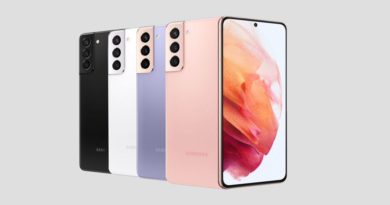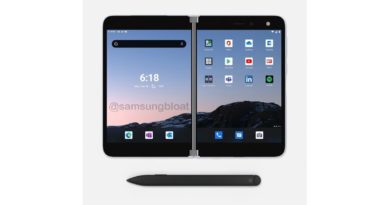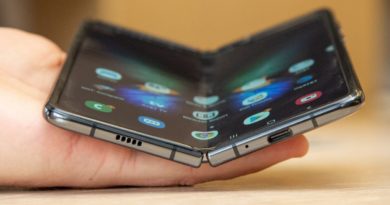Galaxy Z Fold 2 vs. Galaxy S20 Ultra: Which is the ultimate Samsung phone?
What’s the ultimate Samsung phone? Earlier this year, the answer might have been the Galaxy S20 Ultra, the super-sized entry in the Galaxy S20 lineup that boasted mind-blowing specs. From a telephoto lens capable of delivering a 100x zoom to one of the biggest batteries ever found in a Samsung handset, the features of the S20 Ultra helped it to stake a claim as the phone to get when you want the best specs Samsung has to offer.
Since then, though, a new high-end Samsung phone has arrived. The Galaxy Z Fold 2 looks to make us forget all about Samsung’s stumbles with the original Galaxy Fold, with an improved design and a newfound focus on productivity.
A Samsung Galaxy Z Fold 2 vs. Galaxy S20 Ultra comparison pits two of the most expensive Samsung handsets you can buy to find out which one delivers more bang in exchange for all those bucks. We’ve spent time with both devices; here’s how they measure up.
Samsung Galaxy Z Fold 2 vs. Galaxy S20 Ultra: Price
You’d look at the Galaxy S20 Ultra and its $1,399 price and think, “Surely, that’s as much as Samsung will ever charge for a phone.” The Galaxy Z Fold 2 laughs at your naiveté. At $1,999, Samsung’s folding phone costs $600 more than the ultimate S20 model. With that kind of spare change, you could pick up a Galaxy A71 5G as a more modest companion for your Galaxy S20 Ultra.
The Galaxy Z Fold 2 comes in just one configuration with 12GB of RAM and 256GB of storage. Samsung lets you boost the storage on the Galaxy S20 Ultra to 512GB if you’re willing to tack on another $200 to your final tally.
Samsung Galaxy Z Fold 2 vs. Galaxy S20 Ultra: Design
It’s easy to spot Samsung’s different approaches to design with the Galaxy Z Fold 2 and the Galaxy S20 Ultra. With the Ultra, you get a super-sized phone with a very expansive 6.9-inch display, interrupted only by a punch-hole cutout in the top center of the screen to house the phone’s front camera.
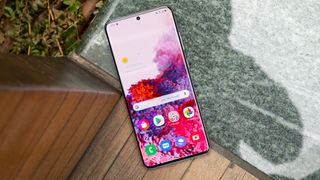
The Galaxy Z Fold 2 greets you with a 6.2-inch display, but you can then open up the phone like a book to reveal an even larger 7.6-inch screen inside.
Like the S20 Ultra, the Fold 2 uses Samsung’s Infinity-O display with that front camera housed in a circular cutout. That eliminates the notch that marred the display on the original Galaxy Fold, making this new foldable much more immersive.
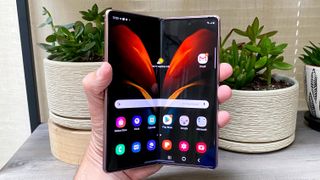
As you might imagine, the Galaxy Z Fold 2 is a lot bigger than the S20 Ultra, even when the former is folded up. While not as tall and wide as the S20 Ultra, the Galaxy Z Fold 2 is much thicker at 0.66 inches to the S20 Ultra’s 0.34-inch size. That makes it rather difficult to carry the Fold 2 in anything other than a coat pocket.
For whatever reason, Samsung has stuck with some pretty staid colors for the Galaxy S20 Ultra, offering the phone in Cosmic Black and Cosmic Gray. The Galaxy Z Fold 2’s Mystic Bronze option adds a little bit more flash to the mix — there’s also a Mystic Black version if you like your phones to look more convention. You also have the option of choosing between four hinge color options for the Fold 2 but only if you order through Samsung.com.
Samsung Galaxy Z Fold 2 vs. Galaxy S20 Ultra: Display
Both the Galaxy Z Fold 2 and Galaxy S20 Ultra offer displays with fast refresh rates, topping out at 120Hz for those times when you want smoother scrolling and more immersive gaming. But not all refresh rates are created equal. Like the Galaxy Note 20 Ultra, the Galaxy Z Fold 2 has a dynamic refresh rate that automatically adjusts the speed of the refresh rate based on what you’re doing.
This means that scrolling and gaming maxes out the refresh rate, while more static activities slows things down to conserve power. With the Galaxy S20 Ultra, you’ve got to manually toggle between 120Hz and the more conventional 60Hz refresh rate.
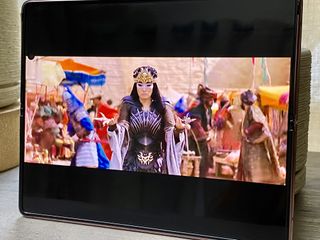
There’s another noticeable difference in screens — the Galaxy Z Fold 2 offers a pair of them. The 6.2-inch outer display on the Fold 2 lets you summon up apps without having to unfold the phone. An App Continuity feature lets you pick up where you left off when you need to use the 7.6-inch AMOLED panel. The Galaxy S20 Ultra has just the one 6.9-inch AMOLED screen.

The S20 Ultra does have a few advantages over that expansive display on the Galaxy Z Fold 2. It’s brighter, for starters, peaking at 662 nits when we measured it with a light meter. The Z Fold 2 topped out at 599 nits. The S20 Ultra also has more vibrant colors, capturing 231.1% of the sRGB color spectrum to the Fold 2’s 206.6% result. (That was measured in the Galaxy Z Fold 2’s Vivid mode.) You may only get one display with the Galaxy S20 Ultra, but it’s a colorful one.
Samsung Galaxy Z Fold 2 vs. Galaxy S20 Ultra: Cameras
On paper, it’s hard to compete with the Galaxy S20 Ultra’s camera specs. It features a 108-megapixel main sensor, along with a 48MP telephoto lens capable of a 100x zoom — a feature Samsung dubbed “Space Zoom.” Those optics are so eye-catching, you almost overlook the 12MP wide angle lens and time-of-flight sensor that also make up the S20 Ultra’s camera array.
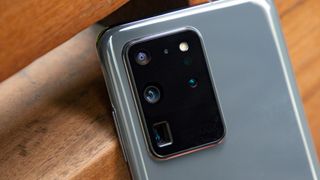
The Galaxy Z Fold 2’s camera setup is more modest, with three 12MP lenses serving as the main, ultra wide and telephoto shooters. That telephoto lens offers a 2x optical zoom and 10x digital zoom — not anywhere near what the S20 Ultra can deliver.
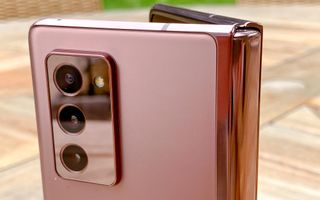
That said, we were a little disappointed with the S20 Ultra’s camera when we tested it earlier this year. The camera had a hard time focusing, and while a software update issued by Samsung tackled that issue, the Galaxy S20 Ultra still struggles in low light and with portrait shots. We do like the detail that its telephoto lens can capture, though the closer you get to the limits of that 100x zoom, the shakier your photos will look, at least without a tripod.
The Galaxy Z Fold 2 takes decent pictures, though it’s outperformed by Samsung’s more conventional phones like the Galaxy Note 20 Ultra. The best thing about the Z Fold 2’s camera is how it can take advantage of the phone’s unique design. The Dual Preview mode, for example, uses both Fold 2 screens as a viewfinder so that the subject you’re photographing can see what they look like before the photo is snapped.
Samsung Galaxy Z Fold 2 vs. Galaxy S20 Ultra: Performance
A Galaxy Z Fold 2 vs. Galaxy S20 Ultra face-off is a great way to see how the Snapdragon 865 Plus performs compared to the standard Snapdragon 865. Both chipsets are Qualcomm’s top-of-the-line mobile processors, but the Plus variant has a faster core clock speed on its prime CPU and it also renders graphics faster.
We see the benefits of all that when we run the two Samsung phones through benchmarks. On Geekbench 5, which measures overall performance, the Galaxy Z Fold 2’s multicore score of 3,193 topped the S20 Ultra’s 3,076 result.
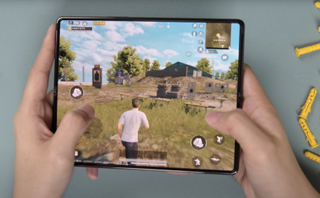
Turning to graphics, the Galaxy Z Fold 2 also had the better result on GFXBench’s Aztec Ruins high-tier offscreen graphics test — 1,461 frames to the S20 Ultra’s 1,319 frame result. It’s not that the S20 Ultra is a weakling by any stretch of the imagination, but the Z Fold 2 offers the edge in performance.
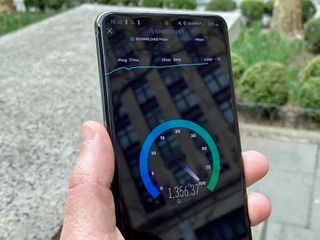
Both phones also offer 5G connectivity. Even better, they work with all flavors of 5G, so you’ll get a connection with either mmWave or sub-6GHz-based networks — provided you’re somewhere with 5G coverage, of course.
Samsung Galaxy Z Fold 2 vs. Galaxy S20 Ultra: Battery life and charging
Big screens — two of them in the case of the Z Fold 2 — and fast refresh rates can put a strain on batteries, but both of these Samsung phones come equipped with big power packs to handle the added demands. The Galaxy Z Fold 2 splits up its power source into two separate batteries that total 4,500 mAh. The Galaxy S20 Ultra dwarfs that with an even bigger 5,000 mAh battery.
Those oversized power packs translate to some pretty good times on our battery test, in which we have phones surf the web continuously over a cellular network until they run out of power — with one significant caveat. The Galaxy S20 Ultra set the pace with an average result of 11 hours and 58 minutes, which is impressive enough to land on our best phone battery life list. The Galaxy Z Fold 2 lasted 10 hours and 10 minutes, just ahead of the average for smartphones, but a good result considering the size of the foldable phone’s screens.
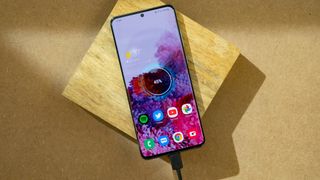
Now about that caveat — those tests were conducted with the displays on the phones set to 60Hz. When we enabled the faster 120Hz rate, there was a hit on battery life. The Galaxy Z Fold 2 lasted 9 hours and 5 minutes when we had its adaptive 120Hz mode enabled. The fall-off was even steeper for the S20 Ultra, which faded after 9 hours and 13 minutes. Of course, the S20 Ultra doesn’t have the benefit of an adaptive refresh rate — it’s a case of all or nothing — which may explain why the hit on battery life was more severe.
Both phones benefit from 25W fast charging, but only the Galaxy S20 Ultra made terrific use of it, even with its larger battery. After 30 minutes of charging a drained S20 Ultra, we got that phone up to 63% of its battery capacity. The Galaxy Z Fold 2 turned in a more disappointing 46% result.
Samsung Galaxy Z Fold 2 vs. Galaxy S20 Ultra: Special features
The Galaxy Z Fold 2’s unique design gives it a huge edge over the S20 Ultra when it comes to comparing the phones’ unique capabilities.
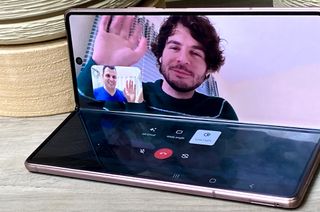
The larger screen on the Z Fold 2 enables features that simply aren’t possible on a conventional phone. that 7.6-inch interior display lets you multitask with three apps at once — you can even pair groups of apps together to launch at once, letting you get right to the task at hand. And with Flex mode, you can position the Z Fold 2’s screen so that half of it is a viewing area while the other half gives you access to control and other features. You can even run apps in expanded mode so that an app like Gmail displays both your inbox and the message you want to read. You can’t do that on an S20 Ultra.
Both Samsung phones support DeX mode, in which you can connect your Galaxy device to a monitor and use it like you would a very portable PC. However, the Galaxy Z Fold 2 lets you do this wirelessly with any monitor or TV that supports Miracast. With the S20 Ultra, you’ll need a cable to attach your phone to an external display.
Samsung Galaxy Z Fold 2 vs. Galaxy S20 Ultra: Bottom line
The Galaxy S20 Ultra is an impressive phablet, and it’s the phone to choose if you want a slimmer design, better-performing cameras and longer battery life. It’s also significantly cheaper than the Galaxy Z Fold 2.
However, the Galaxy Z Fold 2’s expanded internal screen allows you to do more with your phone, and the design changes Samsung has instituted should make this a more durable model than the original Fold. In the Galaxy Z Fold 2 vs Galaxy S20 Ultra battle, the S20 Ultra is the more practical choice, but the Z Fold 2 gives you a phone and tablet in one device for those willing to pay the higher premium.
